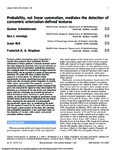Probability, not linear summation, mediates the detection of concentric orientation-defined textures
Date
2015-12-07Author
Subject
Metadata
Show full item recordAbstract
Previous studies investigating signal integration in circular Glass patterns have concluded that the information in these patterns is linearly summed across the entire display for detection. Here we test whether an alternative form of summation, probability summation (PS), modeled under the assumptions of Signal Detection Theory (SDT), can be rejected as a model of Glass pattern detection. PS under SDT alone predicts that the exponent β of the Quick- (or Weibull-) fitted psychometric function should decrease with increasing signal area. We measured spatial integration in circular, radial, spiral, and parallel Glass patterns, as well as comparable patterns composed of Gabors instead of dot pairs. We measured the signal-to-noise ratio required for detection as a function of the size of the area containing signal, with the remaining area containing dot-pair or Gabor-orientation noise. Contrary to some previous studies, we found that the strength of summation never reached values close to linear summation for any stimuli. More importantly, the exponent β systematically decreased with signal area, as predicted by PS under SDT. We applied a model for PS under SDT and found that it gave a good account of the data. We conclude that probability summation is the most likely basis for the detection of circular, radial, spiral, and parallel orientation-defined textures.
Collections
Publisher
Place of Publication
Journal
Volume
Issue
Pagination
Number
Recommended, similar items
The following license files are associated with this item:


